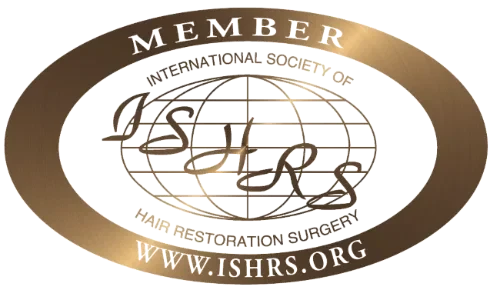Hair Transplant Antalya: DHI & FUE Techniques at DK Klinik
Taboo …
In the early 2000s, getting a hair transplant abroad was still considered taboo by many people around the world.
Today, this taboo is completely dispelled.
Every year, hundreds of thousands of people travel to many countries, especially Turkey, just to have a hair transplant.
It is estimated that 75% of all hair transplants in the world are performed in Turkey.
Turkey stands out among countries like India and Thailand as a leader in the global hair transplant market.
It is enough to do a quick search on the internet to see how popular hair transplantation is in Turkey.
While Istanbul is the city where most hair transplants are performed, Antalya and Ankara are listed as the next most popular cities for hair transplantation.
Away from metropolitan chaos, Antalya leverages its stunning coastline and natural beauty to offer a more personalised, boutique service—establishing it as a premier yet peaceful destination.
 The serene coast of Lara, Antalya. Home to DK Klinik for over 20 years.
The serene coast of Lara, Antalya. Home to DK Klinik for over 20 years.
So, why has Turkey become the world's hair transplant hub?
Why are there more hair transplant procedures performed in Turkey than in all other nations combined?
Is Turkey really successful at hair transplantation?
For example, Jordan, who had his hair transplanted at our clinic a few years ago, says that he had his hair transplanted in Turkey for almost one-fourth of the price in England, that the service he received was top-notch, and that he was quite satisfied with the results.
And he adds,
"I referred at least 10 more people to the clinic I went to for my hair transplant."
Important Note: The fact that most hair transplants in the world are performed in Turkey does not mean that all clinics offering this procedure are safe. Choose clinics that are licensed by the Ministry of Health, preferably with international certifications, supervised by dermatology or plastic surgery specialists, and with a long-standing track record.
The Top Reasons to Choose DK Klinik as Your Hair Transplant Centre in Antalya, Turkey
- As the first hair transplant clinic accredited by the Ministry of Health in Antalya, we host hundreds of patients from all over the world every year.
- The best hair transplant clinic in Antalya, according to medicaldepartures.com.
- Our clinic has been operating in Antalya for 23 years. We are one of the most experienced dermatology clinics not only in Antalya but also in Turkey.
- We prefer the DHI technique in hair transplant operations, but our team can also transplant with the FUE technique if necessary.
- Only doctors and registered nurses make up our hair transplant team.
- We also offer specialised revision hair transplant procedures for patients unhappy with results from other clinics. These complex surgeries require advanced expertise and are performed only by our experienced doctors, correcting unnatural hairlines and improving density for more natural-looking results.
- Free virtual consultations with doctors using the DK Klinik-developed Hair Donor Index for realistic and personalised graft planning.
- We are active members of reputable international organisations, such as ISHRS, EADV, and ESCAD.
- You can find details about our founding doctors and our health tourism competence document on this page.
What Makes DK Klinik Stand Out?
What Makes Antalya Ideal for Hair Transplants
- Easy Access
You can easily reach Antalya without transfers from many cities around the world.
There are direct flights to Antalya from more than 40 countries and over 150 destinations, most frequently from the UK, Germany, and Russia.
- Healthcare Infrastructure Meeting International Standards
Antalya is one of the world's most popular health tourism destinations.
This has led doctors and teams in Antalya to meet the expectations of foreign patients, improve themselves, and maintain high standards of service.
The technological infrastructure of trusted healthcare institutions has been modernised in line with international standards.
- The Opportunity to Combine Holidays and Treatment
According to the Blue Flag programme run by the Foundation for Environmental Education, Antalya has more than 230 Blue Flag beaches and ranks first in Turkey in this regard.
For example, you can swim, sunbathe, and enjoy your holiday at Blue Flag beaches such as Erenkuş, Erdal İnönü, and İnciraltı, which are only a few minutes away from our clinic.
The crystal-clear Konyaaltı Beach is also an excellent option for your holiday.
You can dedicate your last two days to your hair transplant procedure and return home the day after the operation.
- Option to Purchase Package Services
Most clinics offer a single package that includes hotel accommodation, airport transfers, and the operation. This way, you don't have to deal with multiple arrangements.
- Not Mass Service, But More Boutique Service
Istanbul is the city with the highest number of hair transplants in the world. It is known that some clinics operate on more than 30 patients a day.
This poses risks such as not being able to provide sufficient attention to each patient and offering a mass-service approach if the right clinic is not chosen.
Antalya, on the other hand, offers a more boutique service on the unique Mediterranean coast for those seeking to escape Istanbul's cosmopolitan atmosphere.
Important Note: The fact that Antalya is a suitable destination for hair transplants does not mean that all clinics offering this procedure are safe. Choose clinics that are licensed by the Ministry of Health, preferably with international certifications, supervised by dermatology or plastic surgery specialists, and with a long-standing track record.
Reviews and Testimonials
'' I'm Brazilian and I live in London. I had my hair transplant last week at DK Klinik. The clinic is wonderful, with an excellent structure and a highly qualified team.''
Andre Benjamin (See the original review here)
'' Today it's 6 months since my treatment, and I could not be happier. Hair like it has not been for years.''
Christoph Thür (See the original review here)
I would recommend DK Klinik to anybody interested in FUE transplants. A special thanks to Prof. Dr. Ümit Kemal Şentürk, Dr. Meltem Şentürk, and the lovely team for their exceptional service and results.
Naser Yahya (See the original review here).
'' After just a few days, you can see how cleanly and precisely the work was done (including in the donor area). Not many clinics offer the option of using beard hair. The doctor took half an hour the next day after the procedure to discuss my status, the procedure, my blood work, and the postoperative instructions.''
David Glaser (See the original review here)
'' After several months of researching many clinics in Turkey and the UK, I decided to go with DK Klinik mainly because there was never any pressure to commit, and every question I had was answered without any expectations of commitment, which made me feel really at ease.''
James Birtch (See the original review here)
What is Hair Transplantation?
Hair transplantation is a surgical procedure specifically designed for individuals with male-pattern hair loss.
It involves:
Taking grafts from the donor area, usually located on the back of the head, and transplanting them to the balding areas.
Hair follicles collected from the back of the head and the beard area are safe to use as donor areas, as their characteristics closely match those of scalp hair. Hair follicles taken from other parts of the body may disrupt the natural appearance of the hair.
Direct Hair Implantation (DHI) and Follicular Unit Extraction (FUE) are the most commonly used hair transplantation techniques today. Both techniques can provide natural results when performed by licensed professionals in reputable clinics.
Individuals over the age of 30 are considered ideal candidates for hair transplantation because their hair loss patterns have typically stabilised.
Our research shows: At our clinic, after reviewing data from hundreds of hair transplants, we found that the most common age range for the procedure is 35-40, with the average age being 38.
DHI Hair Transplant Timeline: 4000 Graft Transformation at DK
Our Treatment Methods
The hair transplantation technique that we primarily prefer is the DHI method.
However, when necessary, we can also transplant with the FUE technique.
In the classic FUE technique, steel blades are used to create channels, whereas sapphire FUE uses blades with sapphire tips.
While sapphire FUE is marketed today with concepts such as “shorter healing time” and “more natural results,” there is no scientific evidence—or only very limited evidence—to suggest that one of these two blade types is more effective in hair transplantation.
Sapphire is a material that is nearly as hard as diamond, whereas steel is softer but more durable.
This can present various disadvantages or advantages depending on the habits of the person performing the procedure.
Previously, the FUE technique was used all over the world.
Today, the DHI technique has become the most preferred method due to its faster recovery time and more natural appearance.
We have been getting very successful results for years with the DHI method, also known as the Choi Implanter Pen method.
Based on our long-term experience, we use Choi pens with the highest efficiency.
Since hair follicles are of different thicknesses, we use needles with different diameters from 0.5 mm to 1.5 mm according to need.
Since our hair grows at an average angle of 40-45 degrees, we pay attention to this angle when transplanting.
DHI vs. FUE Hair Transplant: Quick Comparison
| DHI | FUE |
| Uses Choi pen | Uses punch tool |
| Implantation without incisions | Implantation after channeling |
| Typically more natural look | Natural, less angle control |
| Faster recovery | Slightly longer recovery |
| Minimal scarring | Minimal scarring |
| Relatively longer sessions | Relatively shorter sessions |
| More consistent precision | Skill-dependent precision |
| Works for most hair types | Works for all hair types |
| Relatively higher cost | Relatively lower cost |
Additionally, we apply PRP (Platelet-Rich Plasma) therapy during the procedure to enhance the survival rate of the transplanted grafts while ensuring a natural appearance.
In this way, we not only increase the survival rate but also make the hair look natural.
Before transplanting the hair follicles, we examine them under a high-zoom microscope in cases where we suspect the grafts might be damaged, replacing low-quality ones with high-quality grafts as necessary.
Since the FUT method is an outdated and disadvantageous technique, we do not use this technique.
One of the most common questions we receive from our patients is:
"Do you offer no-shave hair transplants?"
Yes, we do offer no-shave hair transplants, but with this technique, transplantation of more than 1,200 grafts is not possible, the donor area must be shaved.
Therefore, even if a full head shave is not performed, a beautiful appearance will not be achieved because the donor area is shaved.
If transplantation of more than 1,000–1,200 grafts is performed without shaving, the risk of infection increases.
Therefore, no-shave hair transplant is unfortunately used as a marketing argument and misleads patients regarding the risks it poses. Safe hair transplantation is done by shaving all the hair.
Hair Transplant Cost in Antalya
Our all-inclusive package price for DHI and FUE hair transplantation is 2,000 British Pounds (£), while our standard package without hotel accommodation is 1,800 British Pounds (£).
To secure your booking, we require a 20% prepayment, which is processed through İşbank's secure payment system, with the remaining balance payable in cash or by credit card at the clinic.
We do not price based on grafts. Our goal is to add the most accurate number of grafts that will cover any possible open areas. We maintain our transparency policy in terms of pricing as well. You won't encounter any additional costs beyond the one given to you.
The services included in the standard package price are as follows:
- Free Detailed Consultation (in-person, virtual, or via WhatsApp)
- Hair transplant up to 5,000 grafts
- Detailed Blood Analysis
- Post-care shampoos and pills
- City transfers
- English-speaking assistants
- PRP during the procedure
- Pain Control Device with Local Anesthesia
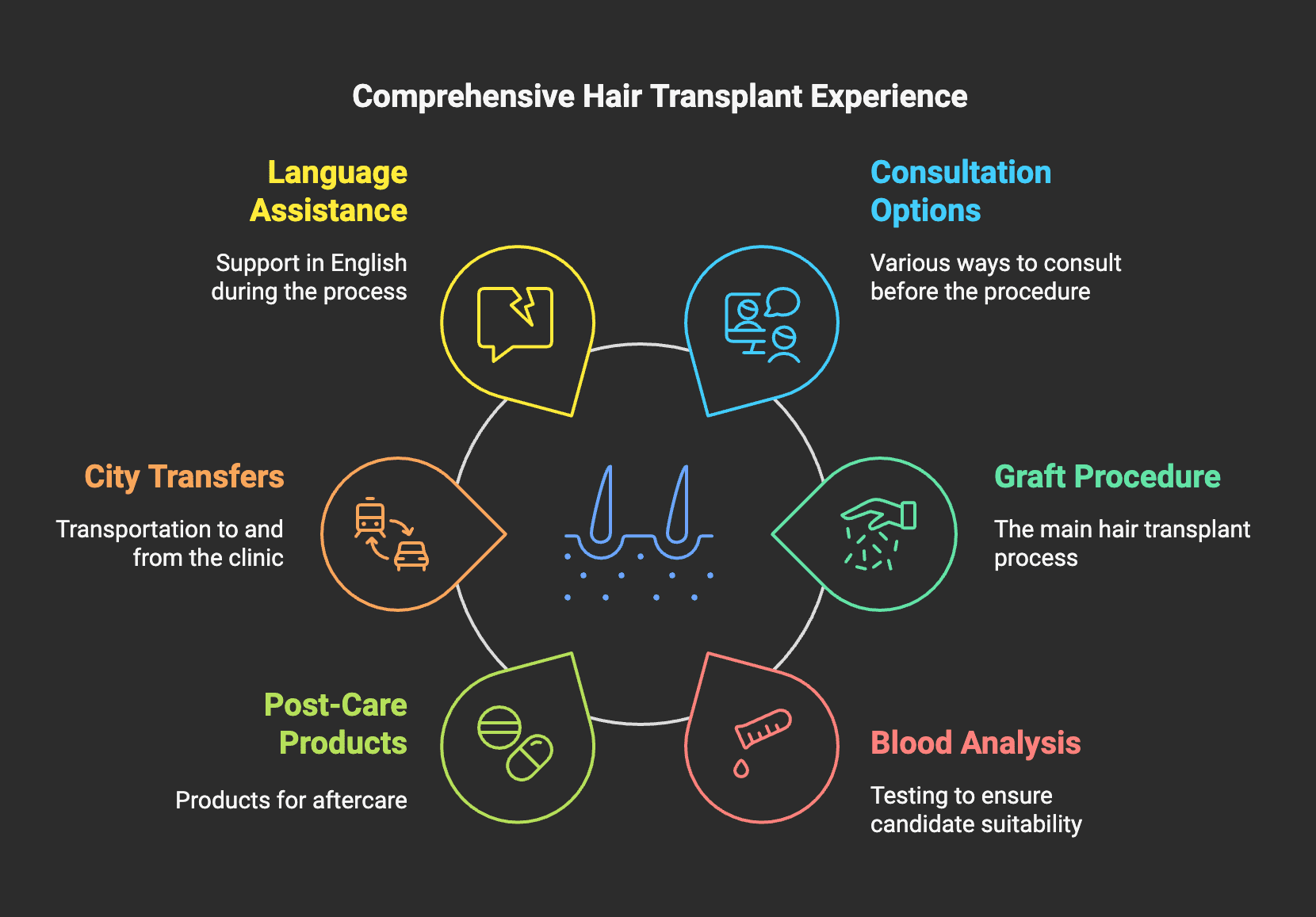
Antalya Hair Transplant Cost vs Global Destinations
Note: We determined these average prices by reviewing the prices of more than 50 clinics operating in various countries and from multiple sources. Prices may vary depending on exchange rate fluctuations and individual clinic pricing policies.
Before & After
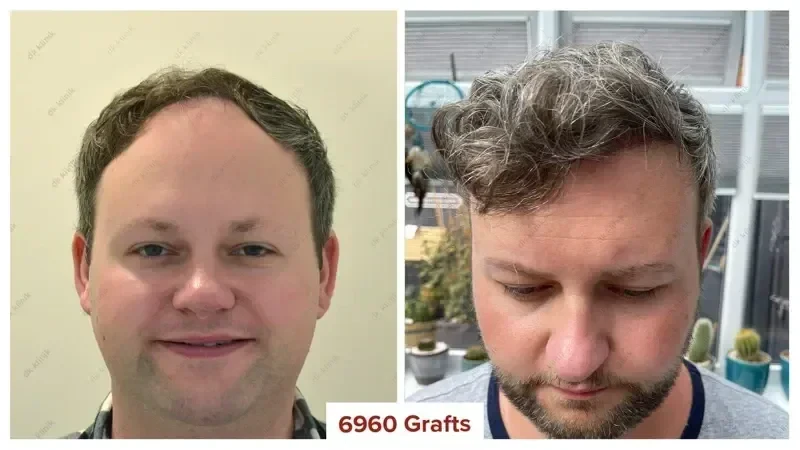
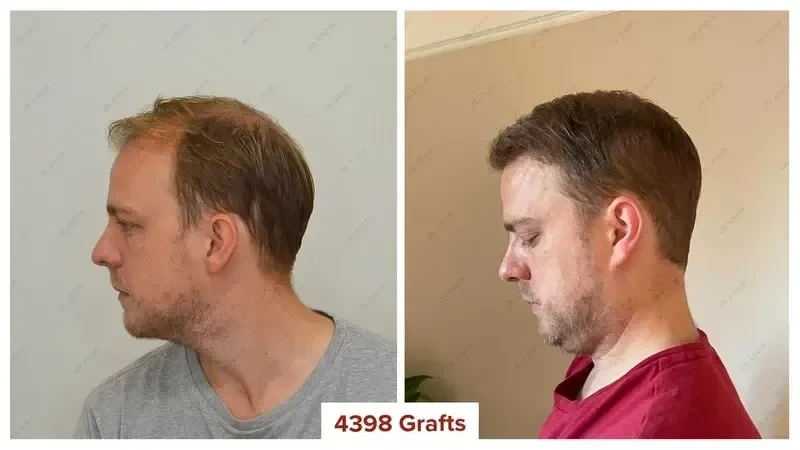
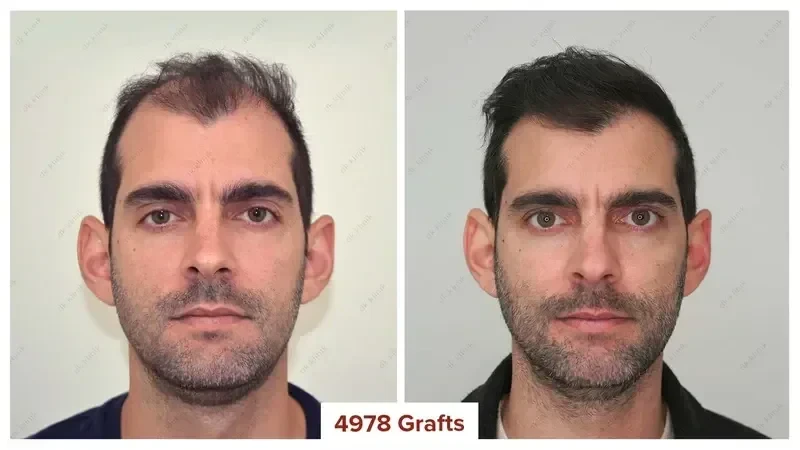
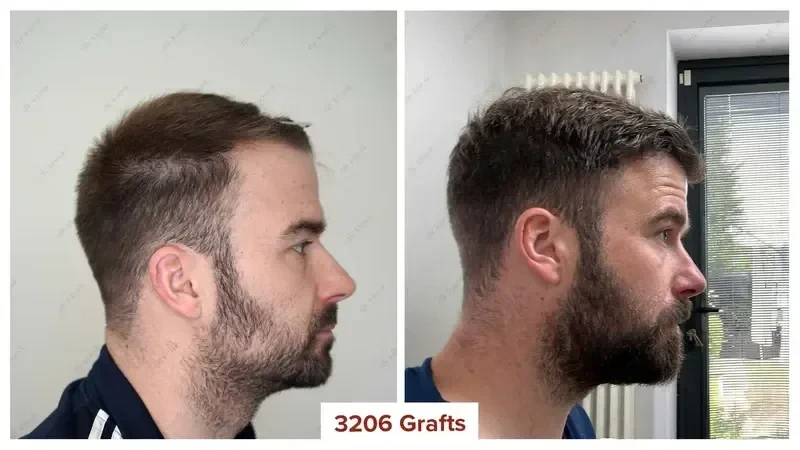
⇒ Explore our full Before & After gallery
Steps For International Patients In Antalya: Packages and Other Details
Hour-by-Hour Hair Transplant Schedule (Brief Overview)
A Day Before The Operation: 11:00 - 11:30 Blood withdrawal for extensive analysis of hair metabolism parameters
Operation Day Schedule:
09:00 - 09:30 Pick-up from hotel and arrival at clinic
09:30 - 09:45 Registration for medical records and payment procedure
09:45 - 10:15 Consultation, hairline design and operation preparation (shaving, medication administration, measuring blood pressure, oxygen saturation, and hair density)
10:15 - 10:30 Local anesthesia administration
10:30 - 13:00 Graft extraction
13:00 - 14:00 Lunch break (Choose your meal from our clinic's menu)
14:00 - 17:00 Graft implantation
17:00 - 17:15 Final checks, dressing and bandaging
17:15 - 17:30 Post-operative care instructions
17:30 - 18:00 Return transfer to hotel
Day After The Operation: 12:00 - 12:30 Detailed information about post-operative care
12:30 - 13:00 Removal of bandages and first washing
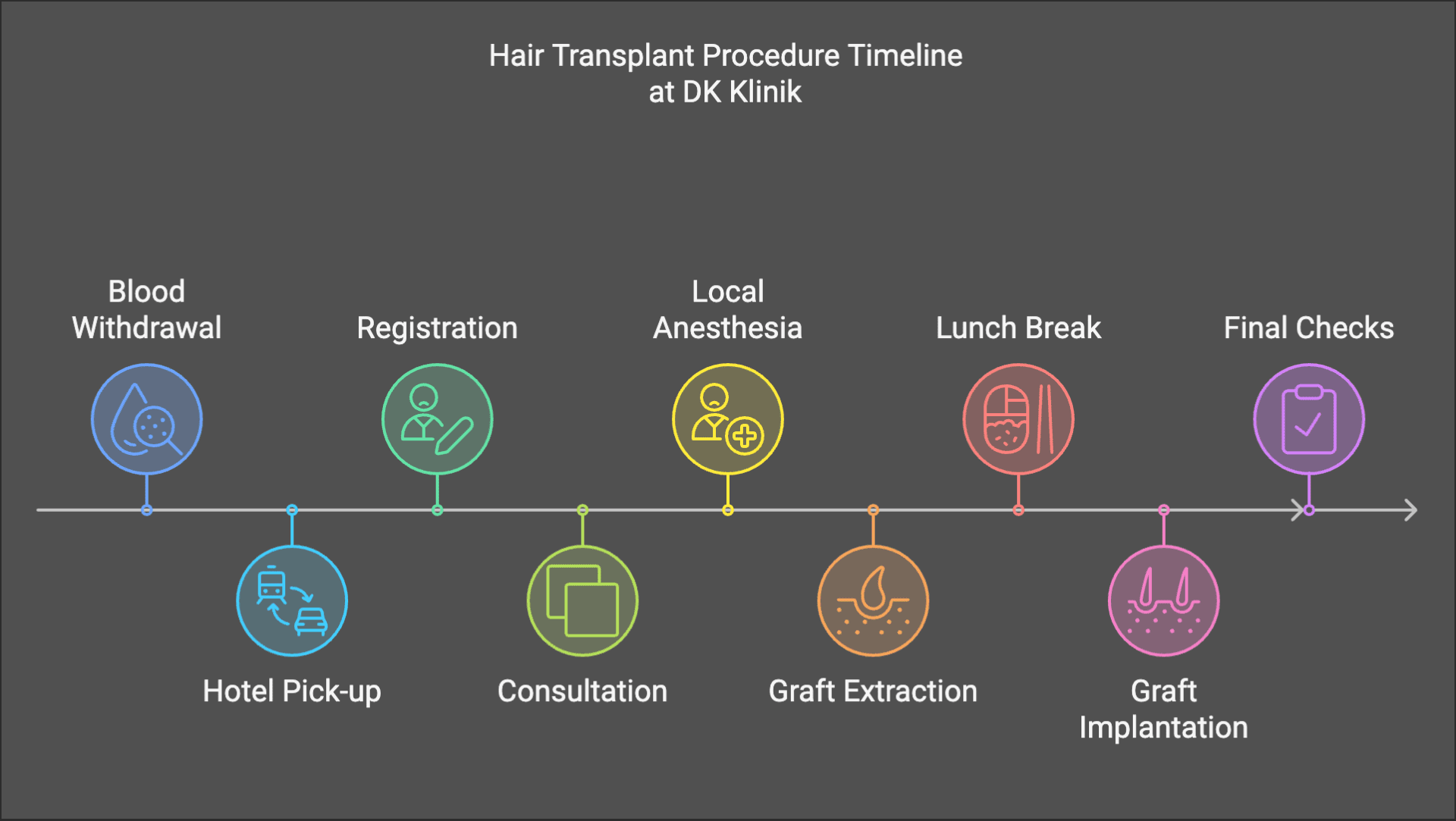
A Complete Step-by-Step Guide
1. Consultation Phase
Usually, our first communication with patients starts via WhatsApp or e-mail.
We offer you a free online consultation after you get in touch with us.
After seeing your pictures, we provide information such as how many grafts you need, how many days you need to stay here, and how much it will cost.
At this stage, we give detailed answers to all the questions that come to your mind.
2. Booking Phase
At this stage, we would like you to share with us which dates are available for you.
We check our availability on the dates you provide, and if we have space for the operation on those days, we ask you to buy your plane tickets.
After purchasing your flight ticket, we will send you a prepayment link to guarantee your hair transplant reservation.
We take an amount equal to 20% of the total amount as a prepayment and confirm your reservation.
You can make your own hotel reservation or stay in one of our partner hotels.
DK Klinik provides all city transfers for free after your arrival at the airport.
⇒ Whatsapp Us Now For Your Free Hair Transplant Evaluation
3. Blood Analysis
Hair transplantation and beard transplantation are both surgical operations.
Before each surgical operation, various blood tests are performed for both the health of the person and the safety of the surgical team.
We screen for HIV and hepatitis viruses and check for any bleeding or coagulation issues.
We check for any underlying disorders, anemia, or general infections in the patient.
In addition, there are hormones, vitamins, and minerals that affect the health of the hair.
Thyroid hormone imbalances (more commonly seen in women and often leading to women’s hair transplant consultations), some vitamin deficiencies, and deficiencies or excesses in minerals can also cause hair loss.
These imbalances can negatively affect the growth of hair and the formation of new cell structures.
If there is such a defect, it must be corrected. In the blood test we do, we check these values.
In this way, we have the chance to intervene for other reasons that will affect the success of the operation.
4. Hair Shaving
One of the most challenging issues for people who decide on hair transplantation is shaving the hair.
That's why some clinics claim to offer unshaven hair transplantation.
However, unshaven hair transplantation is quite risky. The possibility of hair sticking together increases the risk of infection.
Therefore, the hair must be completely shaved.
However, in transplants that do not exceed 1000–1500 grafts, shaving only the donor area is often sufficient.
Before the operation, we shave your hair with the help of a machine.
If the beard needs to be used as a donor, the beard area is also completely shaved.
5. Frontal Hairline Design
A natural hairline is one of the most important conditions for a successful hair transplant.
A bad hairline design can ruin a normally perfect hair transplant on its own.
Therefore, in our clinic, we pay great attention to designing the front hairline in the most appropriate way for the patient.
The following conditions should be considered for a good hair transplant design:
- At least 10 days before the hair transplant, the patient should stop shaving their hair so the specialist who designs the transplant can see the natural hairline and design a better hairline
- The age of the person should be considered when designing the hairline. As people age, the front lines of their hair go backwards.
For example, the front hairline of a person who has reached the age of 35–40 should differ from the front hairline at 18. Otherwise, an unnatural, childish appearance may occur after hair restoration.
The patient’s expectations are important. Some people may want the front hairline to be slightly higher or lower.
If possible, the person's expectations should be considered.
A natural hairline should be neither too close nor too far from the eyebrow area.
Men's and women's hairlines are different. Gender differences should be considered while designing.
6. Local Anesthesia
After the front-line design is made, the preparation phase for the operation begins. Before local anaesthesia, we measure and record important values, such as blood pressure, pulse rate, oxygen saturation, etc.
At this stage, before starting the operation, the person should be asked how he feels.
If the patient is very anxious, it may be necessary to wait for a while, or a low-dose sedative may be given.
An anxious mood can affect blood pressure levels.
Therefore, the person's blood pressure should be measured and observed to see if it is under control before the operation.
If all is well, the person is placed in the hair transplant bed, and local anaesthesia is applied to the scalp. Injections are administered.
Approximately 15-20 injections are applied to the scalp.
According to our observations, our patients only feel the pain of the first 4-5 injections.
After 4-5 injections, the head becomes numb, and the pain decreases gradually.
At this stage, any pain is minimal and not bothersome, and the effect of local anaesthesia increases as the number of injections applied to the skin increases.
To make sure that the anaesthetic is working, the specialist applies pressure to different areas of the scalp. If the patient still feels some pain, one or two more injections of anaesthetic are administered.
Anaesthesia in hair transplantation can be done in different ways.
Accepted practice in the world is the injection of an anaesthetic substance into the head via injection.
7. Collecting the Grafts
After the application of local anaesthesia, the stage of "collection of grafts," which is the basis of the hair transplant operation, is started.
Grafts are collected one by one from the donor area using a device called a micro-motor.
Depending on the thickness of the hair follicles and the number of hairs, punches with a diameter of 0.8 to 1.2 mm are used to extract the grafts.
Each follicular unit is carefully extracted from the scalp in a cylindrical shape. These punches rotate at 3000–3500 revolutions per minute.
Thus, thanks to the micro-motor device, the grafts are collected one by one.
There are various types of sharp-edged punches that allow you to cut the hair root from the skin and remove it.
Which of these punches will be used depends on the condition of the hair follicle and skin.
A hair transplant centre must have a diverse punch portfolio.
Today, the operation time has been shortened thanks to the micro-motor.
Thus, patient comfort has increased.
Therefore, the collection of grafts with a micro-motor compared to the collection of grafts with the manual punch technique is more efficient.
8. Separation of Grafts
This stage is not mentioned in most places, but it is a very critical stage. Not all of the grafts collected are intact.
Some of the collected grafts are waste and cannot be transplanted.
Since these grafts are weak or broken, they cannot hold on to the scalp even if they are transplanted.
In a hair transplant planned as 3500 grafts, about 2% to 10% of the grafts are often broken.
Therefore, broken grafts should not be transplanted into the patient.
If these broken grafts are transplanted, the patient may end up with significantly fewer viable grafts than initially planned.
Therefore, the result is negatively affected.
We use a microscope to accurately detect and eliminate damaged grafts that would otherwise go unnoticed, where it is not possible to distinguish if the grafts are broken.
9. Transplantation of Quality Grafts:
The separated grafts are placed in a hair transplant pen and transplanted one by one.
This pen-shaped tool is specially designed for the DHI procedure, which is also called the Implanter Pen technique.
When undergoing transplantation, grafts should be transplanted at an angle appropriate to the growth direction of the person's hair; otherwise, an unnatural appearance will occur.
10. Post-Operation
Our patient visits our clinic the day following the completion of the hair transplantation for the initial washing of his hair.
Our nurses wash the patient's hair. The initial wash should be performed by experts because it is crucial.
Our doctors explain to our patients what to look out for and how to wash their hair after washing.
Hair Transplant Recovery Phase
The healing process after hair transplantation is a process that requires patience, attention, and care.
It is important for the success of the procedure and your health to protect the transplanted area, especially in the first days, not to expose it to trauma, and to pay attention to the hygiene of the donor area and the transplantation area.
It is critical to follow the instructions given by your doctor and perform hair washing procedures correctly.
Oedema, sensitivity, redness, and crusting are the most common findings in the first 15 days following hair transplantation.
⇒ Book Your Hair Transplant Appointment Now
Recovery Timeline
- Day 1-7: The two most noticeable signs in the donor area and the transplantation area are oedema and redness.
- Day 7-14: The most noticeable change during this period is the crusting in the planting area, which changes from a light brown to a very dark brown colour.
- Day 15-30: The skin regains its normal appearance, but there is a slightly pink appearance in the transplantation area. The donor area regains its normal appearance. People frequently observe itching in both areas during this period.
- Day 30-90: Several people experience the loss of some or all of their transplanted hair during this period. What is shed here are strands of hair, but the hair follicles continue to live inside the skin. Some people may see their first hair growth during this period, despite not expecting it.
- Day 90-180: This is the period when the transplanted hair starts to grow. Generally, growth accelerates after the fourth month. The fastest growth period is between the 4th and 6th months.
- Day 180-360: This marks the completion of growth between 6 months and 12 months. Usually, we see the end result at the end of the 12th month, but the crown area reaches the end result in the 16th month.
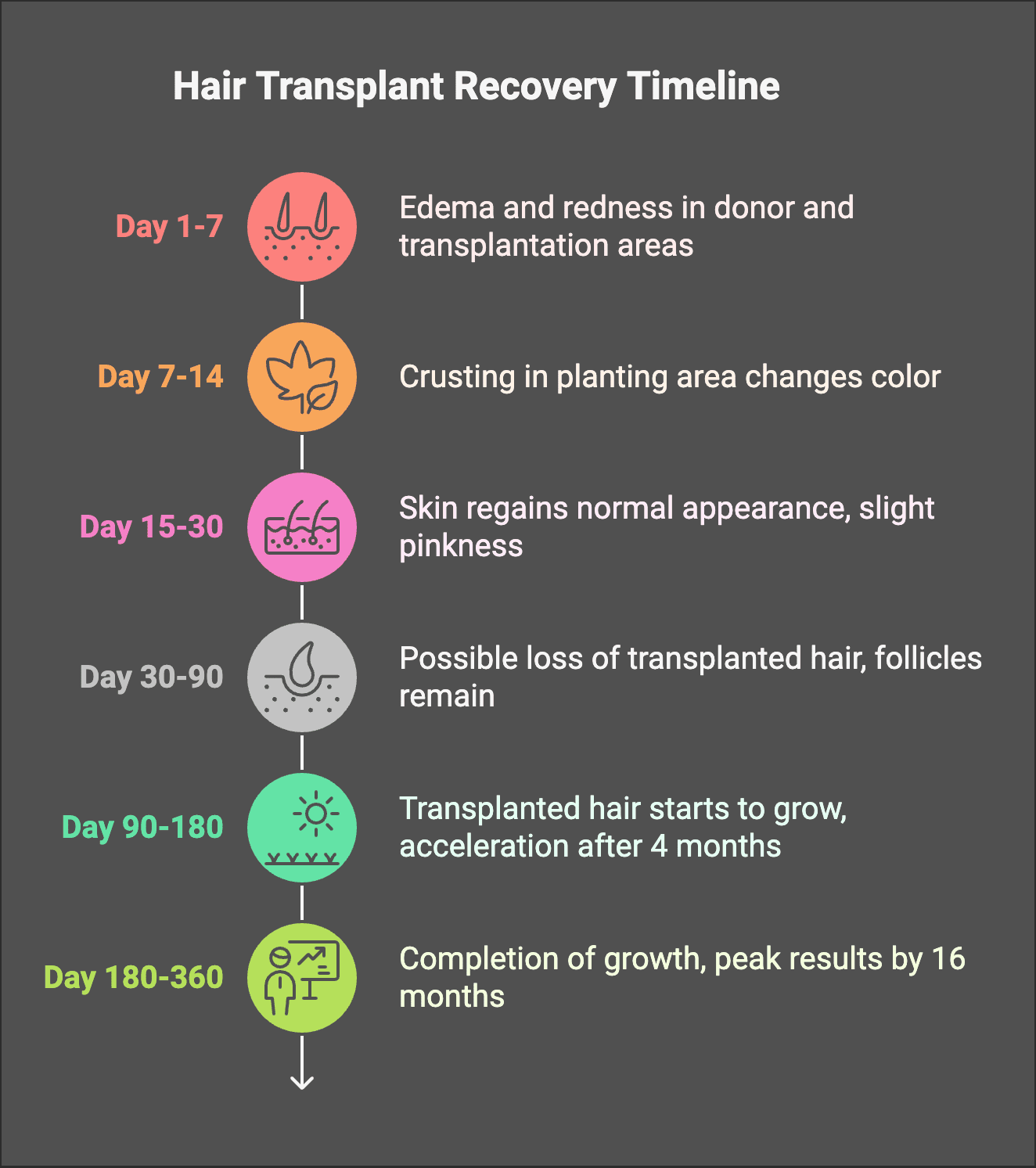
Common Symptoms and How to Manage Them
- Pain: It is normal to feel moderate pain. If you experience pain, use the painkillers provided to you.
- Oedema: Swelling and oedema are expected conditions after surgery. This swelling can sometimes extend to the area under your eyes. It usually lasts for 2 to 5 days after the operation. Among the medications we have given you, there is an anti-oedema medication to help reduce swelling. If you use the headband we provided for 3 days, the swelling and oedema are expected to remain limited.
- Itching: After hair transplantation, itching may occur across the entire scalp. Washing your hair regularly according to the instructions we provided and maintaining proper hygiene in the area will reduce itching. However, some individuals may experience more intense itching, which can last for 1 to 2 months. In this case, please contact us. With the help of certain antihistamine medications we can recommend, the itching can be brought under control.
- Scabbing: During hair transplantation, micro-cuts are made in the area where the grafts are placed. For example, in a transplant of 3000 grafts, 3000 micro incisions are created. These incisions are essentially small wounds, and as they heal, fluid accumulates in the areas along with tissue regeneration. These fluids dry and harden over time, forming protective scabs. Scabbing is a natural mechanism developed by the body to protect itself from external factors and infection while repairing the tissue. These scabs will fall off as the healing process completes. Crusting is a natural process and will shed more easily with the shampoo and lotion we provided you.
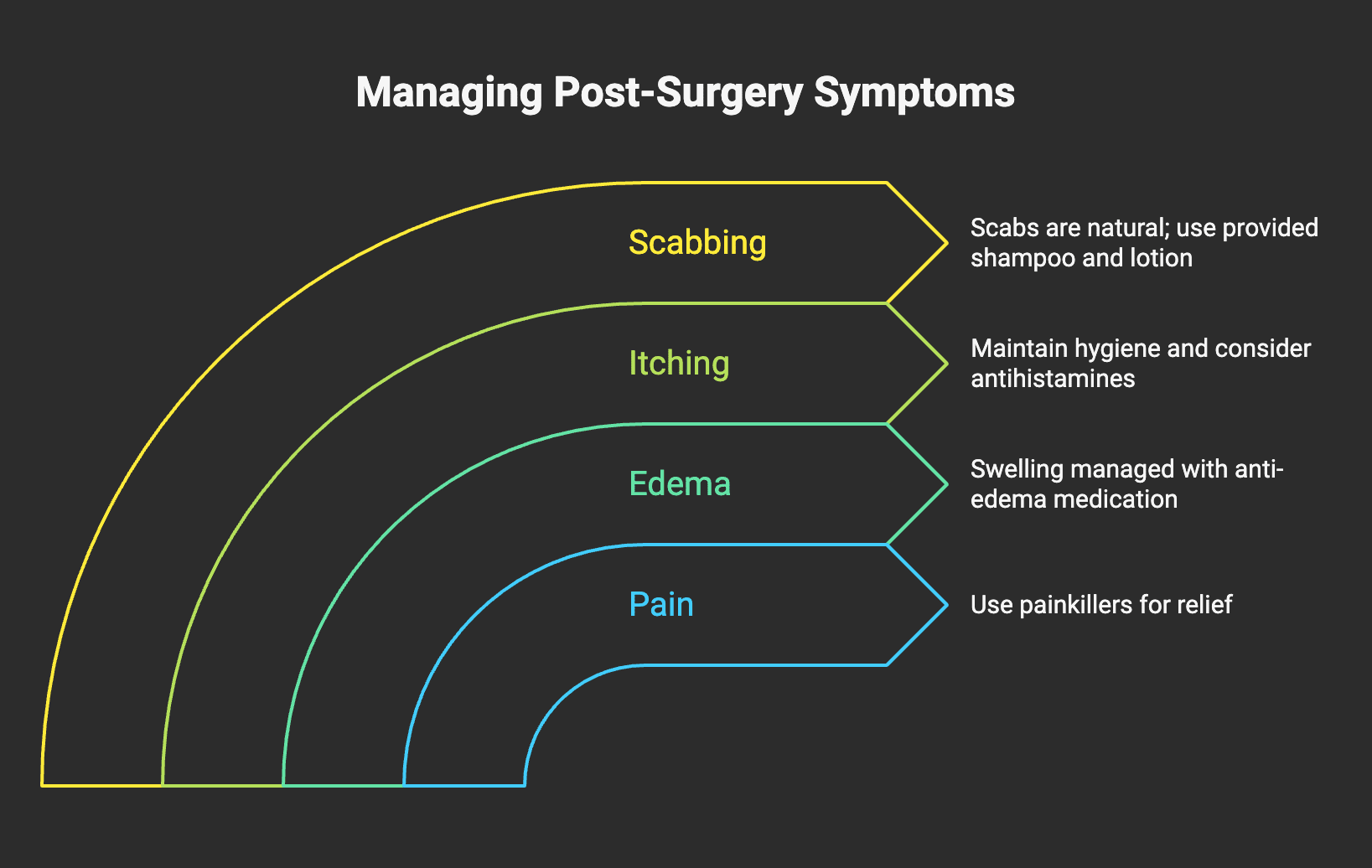
Activities to Avoid During Recovery
- Cigarettes and alcohol should not be consumed for 7 days.
- For 3 months, avoid sunbathing, intense sunlight, saunas, and tanning beds.
- For the first few weeks, refrain from touching the donor and transplant areas.
- For the first week, no exercise should be performed.
- In the second week, light walks are allowed, but other exercises should definitely be avoided.
- Between the 3rd and 4th weeks, running and lifting light weights are permitted, but a shower should be taken immediately after sweating. Other sports activities should still be avoided.
- After the 4th week, you can resume your desired exercises and sports, but it is essential to shower following your sweating.
- Sexual activity should be avoided during the first week. From the second week onwards, it may be resumed gently, avoiding excessive sweating. Between the 3rd and 4th weeks, you can return to your usual sexual routine, but you should take a shower after sweating.
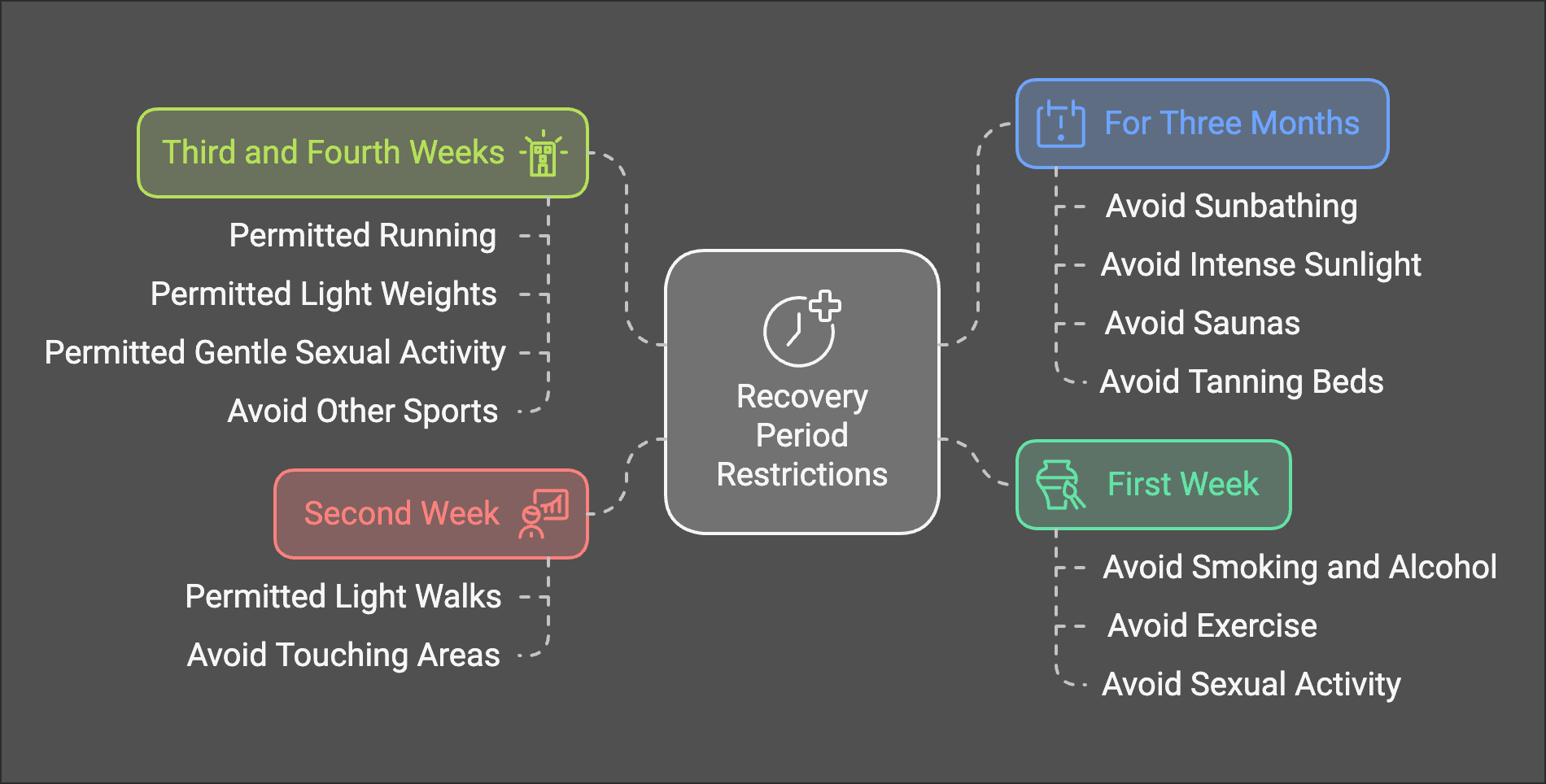
How many grafts do I need?
The Norwood-Hamilton scale is used to estimate how many grafts will yield satisfactory results.

However, according to our experience and observations from thousands of hair transplants, the accepted graft numbers according to this scale rarely give satisfactory results.
Therefore, we transplant approximately 25% more grafts than the recommended number of grafts according to this scale.
If there are not enough grafts in your donor area, we also use the beard area as a donor area and try to get the best possible result.
You can contact us to find out exactly how many grafts you need.
What should I do before hair transplant?
- Stop smoking 2 days before the procedure.
- Stop alcohol consumption 3 days before the procedure.
- Stop taking Aspirin and other blood thinners 5 days before the procedure.
- Stop taking anti-inflammatory drugs (such as ibuprofen) categorized as strong painkillers (you can consult us for a drug list) 3 days before the procedure. You can use painkillers that contain paracetamol.
- Stop using minoxidil-containing solutions intended to prevent hair loss 3 days prior to the procedure.
- Vitamins B and E should be discontinued one week in advance due to their potential to increase bleeding.
- If your multivitamin supplements contain these vitamins, stop using them too. Stop taking supplements containing ginseng, ginkgo biloba and garlic extracts 1 week before the procedure..
- Do not consume too much tea, coffee or coke on the day of your operation.
- Do not consume herbal teas that you are not sure of their ingredients for at least one week before the procedure. Some herbs have a blood-thinning effect.
- Avoid exposing your head to too much sunlight especially in summer for about 2 weeks in advance. It is very important that your scalp is not tan or sunburned.
- Your hair will be trimmed at our clinic before surgery.
- You should wash your hair in the morning before you come to our clinic.
- If you regularly use any drugs for a medical condition (such as hypertension, thyroid, cholesterol, diabetes), you may continue using them. However, you should inform your doctor of any medication you are taking. All medications related FUE will be provided after hair transplant session.
- You can have breakfast before the procedure; you do not need to have an empty stomach prior to surgery. We will also have a break so that you can eat lunch.
- Because it is a long procedure, you are advised to wear loose, comfortable clothing and shoes. It is important to wear buttoned clothes or wide-fit t-shirt, as these are easier to take off after the procedure. In addition, it would be wise to bring extra clothing.
- We do not recommend driving after the surgery due to the anesthetics and prolonged inactivity during the procedure. You should arrange transportation accordingly.
When can I see the first and the end result?
Within 15 days after the hair transplant, you will see that the transplanted hair begins to grow.
This continues for a while and then the transplanted hair will fall out at 2-3 months after the procedure.
It will start to grow back in the third month after falling out, which will be your permanent hair. Usually one year after the surgery, patients begin to see the final results.
Will I be awake during hair transplant procedure?
At our clinic, all FUE procedures are performed while the patient is under local anesthesia, so if you like, you can listen to music, watch movies, or play with your phone during the operation.
What is the success rate of hair transplant at DK Klinik?
We can say that the risk of failure is rather low in a hair transplant performed under the supervision of specialist.
At a licensed hair transplant center, the success rate of the transplanted grafts ranges from 85% to 95%.
The four biggest indicators of a successful hair transplant are as follows:
- Are at least 90% of the transplanted grafts alive?
- Despite the limited donor area, did we achieve the best possible result?
- Do the results look natural?
- Are there any clearly visible scars in the scalp?
If we answer "yes" to the first three questions and "no" to the fourth question, we can say that the hair transplant was successful.
In our clinic, we do our transplants according to these success criteria and reach our goal.
Am I the right candidate for hair transplant?
A good candidate should meet the following criteria:
- The hair loss should be at stage 2 or above based on the Norwood-Hamilton Scale.
- The significant hair loss period should be completed or near completion despite every conservation efforts (even if it varies from person to person, the best time for a hair transplant is after the age of 30, because it becomes easier to predict future hair loss after that age)
- The donor region should yield healthy grafts enough to cover recipient areas. Higher density of hair in the donor region means denser hair in the recipient areas.
In extreme cases like severe hair loss due to trauma, injury, burns, or surgical procedures, people can get a hair transplant without any regard to the criteria above.
- In people with matching hair color and scalp color, the results of hair transplant tend to be better.
- In people with thick hair, the same number of grafts usually can yield more satisfactory results as compared to people with thin hair strands
- In general, good scalp flexibility allows easier hair transplant, increasing the success rate of the restoration.
How long does the surgery take?
The operation usually takes 6 to 8 hours.
If the beard area is also used and more than 4,000 grafts are transplanted, the procedure may take an additional 1–2 hours.
Does the hair transplant room meet surgical operation standards?
The hair transplant room is kept at a precise 21°C (70°F) temperature to ensure the best comfort and graft survival. It is fully prepared to meet all the standards for surgical operations and is regularly inspected by the Ministry of Health.
Is hair transplant surgery painful? What pain management options are available?
Since hair transplantation is performed under local anesthesia, there is no pain during the procedure.
However, the administration of local anesthesia takes a few minutes, and the needles applied to the scalp may cause some pain during this time.
Thanks to the Canadian-origin, FDA-approved pain control device that we started using as of 2024, the pain caused by injection needles has been greatly reduced, making the process much more comfortable and painless.
The mechanism of action of the device:
1. The patient breathes in small amounts of a gas mixture consisting of 50% nitrous oxide and 50% oxygen administered by the device.
2. The gas delays pain signals from reaching the brain.
Additionally, it reduces the sensation of pain by suppressing areas such as the amygdala, which controls brain functions related to anxiety and stress, and by increasing the release of endorphins.
Will I need a second hair transplant?
There are several scenarios where a second planting is required.
The most common scenario we encounter is that there is not enough graft in the donor area of the patient to cover the open areas in his head.
For example, 4500 grafts are required to close the patient's open areas, but only 2500 grafts can be collected from the patient's donor areas.
In such a case, it is necessary to wait about a year for the results to be seen after the first planting.
After 1 year has passed, it is the best decision to reevaluate the donor area and, if possible, perform the second transplant.
Those who want to have a hair transplant at an early age may need a second transplant in the future because hair loss usually continues in people under the age of 30.
Although the transplanted grafts do not shed, the remaining hair sheds, so second or even third transplants may be required to close the open areas in the hair at later ages.
The images below show a patient requiring two hair transplant procedures for optimal results:

Is hair transplant a permanent solution?
The short answer is that the transplanted hair will be permanent. The area where hair follicles are extracted is called the donor region. This area is also called the “reliable donor area”.
The hair follicles in the reliable donor area are very strong and healthy.
Generally, the hair in the donor region is genetically programmed to resist hair loss. You can see that someone who starting going bald at a young age still has hair in the donor site even after he is 70 years old.
The hair follicles used in hair transplant are extracted from the reliable region will keep the same genetic codes and characteristics as those in the donor region.
So as long as the hair in the donor region continues to grow, the transplanted hair will continue to grow too.
Following the hair transplant, once your hair begins to grow longer, you can wash, cut, comb or dye your hair, because this hair will be stronger and always keep growing .
- You should avoid illegally operating hair centers. Find an expert clinic with a skilled doctor.
- People with no predictable hair loss pattern should delay getting a hair transplant.
- You should follow your doctor’s advice and use the medication regularly your doctor prescribes (if any) after the procedure.
- No region of the body other than the back of head and moustache area should be used as the donor region (such as breast hair etc.)
What are the risks and side effects of hair transplant surgery?
In accredited healthcare centers, hair transplant procedures performed under the supervision of a dermatologist or plastic surgeon are reliable, and the risks are minimized.
Therefore, to minimize potential cosmetic and surgical risks, avoid illegal businesses that operate underground.
Like any surgical procedure, hair transplant surgery also carries various risks:
- After the operation, pain, bruising, temporary numbness, redness, and bleeding may occur. These are temporary and normal.
- Shock loss may be observed a while after the procedure; during this period, all the transplanted hair temporarily falls out, which is a situation we encounter quite frequently. The hair will start to grow back after some time.
- In some patients, an infection called folliculitis may be observed on the scalp. In this infection, small inflammations occur in the hair follicles, which can be treated with antibiotic therapy and adherence to hygiene rules.
- In hair transplants performed in unlicensed or unregulated establishments, scars and thinning may be observed in the donor area. In accredited and reliable healthcare institutions, this risk is quite low.
What measures do we take to keep these risks at the lowest level?
- We keep the surgical team away from a hectic schedule and ensure they have the necessary rest periods.
- We maintain high hygiene standards in our clinic and operating rooms.
- We discuss factors that could pose a risk to patient health in our regular meetings and ensure that the entire team is aware of them.
- After our patients return to their countries, we maintain close communication with them, regularly request their photos, and examine them. Thus, if we observe a condition like folliculitis that could affect the patient's health or the outcome of the operation, we provide the necessary guidance. By doing so, we take our precautions before potential risks arise.
I don't speak Turkish. Will I face any communication problems at your clinic?
No, you do not need to speak Turkish. In fact, almost none of our patients have spoken Turkish so far, apart from our Turkish patients. Our medical team, including doctors and nurses, speaks English fluently. Two of our hair transplant nurses are also fluent in English, while the others have an intermediate level of English proficiency. Additionally, our reception team is highly proficient in English.
We also have Russian- and German-speaking professionals in our clinic to assist you.
What's the best time of year to get a hair transplant in Antalya?
Antalya is one of the hottest cities in Turkey on average. This, combined with its many blue-flag beaches, has made Antalya one of the most popular holiday destinations in the world.
While hot weather and direct sunlight can increase sweating and make post-transplant care more challenging, it is entirely possible to protect yourself from these conditions with proper precautions.
If you are planning to visit for a hair transplant during July, August, or September and also want to enjoy a holiday, scheduling your hair transplant for the last 1-2 days of your trip is an excellent option.
For the rest of the year, the milder weather makes it easier to avoid heat and sweating. If you feel you might struggle to protect yourself from the heat and sweating, it may be more practical to schedule your hair transplant during months outside of these three.
Where exactly is your clinic located in Antalya?
Our clinic is located in the Şirinyalı district of Lara, Antalya. We are just 13 kilometers from Antalya International Airport, a convenient 15-minute drive. Five-star hotels such as Akra Barut and The Marmara Antalya are within walking distance. There are also numerous boutique hotels in the vicinity. If you're in Şirinyalı, you can easily find us located directly between McDonald's and Starbucks.
Our Address: Şirinyalı, İsmet Gökşen Cd. No:14/C, 07160 Muratpaşa/Antalya
Do UK and US Citizens Need a Visa to Get a Hair Transplant in Turkey?
No, British and American citizens do not require a visa to travel to Turkey for hair transplantation. Hair transplantation is within the scope of health tourism, and British and American citizens can reside in Turkey for 90 days in any 180-day period.
The duration of stay for hair transplantation is usually 2-4 days and does not require a visa.
How much can UK and USA patients save by having a hair transplant in Antalya and Turkey?
Considering that an average hair transplant requires 3,000–3,500 grafts, the cost in the UK ranges from £10,000 to £15,000, while in the USA it varies between £13,000 and £18,000.
In Turkey, on the other hand, prices average between £1,500 and £2,500 — which means a saving of at least 80%.
| COUNTRY | AVERAGE COST (3,000–3,500 GRAFTS) |
| 🇬🇧 United Kingdom | £10,000 – £15,000 |
| 🇺🇸 United States | £13,000 – £18,000 |
| 🇹🇷 Turkey | £1,500 – £2,500 |
Are there direct flights from the UK to Antalya?
Yes, many airlines, such as SunExpress, easyJet, Wizz Air, Corendon, and Pegasus, operate direct flights to Antalya from various destinations in the UK.
Although the frequency of flights and the number of routes increase in spring and summer, there are direct flights throughout the year. Flight times vary between 4 and 4.5 hours.
You can find direct flights to Antalya from London, Birmingham, Newcastle, and Bristol all year round, regardless of the season.
Direct flights from cities such as Edinburgh, Glasgow, Leeds, and Belfast may be seasonal or have limited weekly frequency. Especially after June, the number of flights increases significantly during the summer season.
As Antalya has become an increasingly popular destination among British travellers, the number of airlines and direct flights to Antalya continues to grow each year.
✈️ Direct Flights from the UK to Antalya
| Departure City | Airport Code | Airline(s) | Flight Time | Operating Days (Peak Season) |
| London | LGW / LTN / STN | easyJet, SunExpress, TUI Pegasus | ~4h 15min | 20+ flights/week |
| Manchester | MAN | Jet2, TUI, SunExpress | ~4h 30min | 20+ flights/week |
| Birmingham | BHX | Jet2, TUI, SunExpress | ~4h 30min | 15–20 flights/week |
| Edinburgh | EDI | Jet2, easyJet | ~4h 30min | 6–8 flights/week |
| Bristol | BRS | easyJet, TUI, SunExpress | ~4h 30min | Up to 18 flights/week |
| London Heathrow | LHR | British Airways | ~4h 10min | 4–6 flights/week |
| Newcastle | NCL | Jet2, SunExpress, TUI | ~4h 30min | 10–12 flights/week |
Are consultations available online before traveling?
Yes, a free hair transplant consultation is available. You can send your photos via WhatsApp, email, or Instagram to receive advice from our experienced hair transplant team, or request a free virtual consultation. In that case, you can have a video consultation with Dr. Meltem Şentürk or Dr. Ümit Kemal Şentürk at no cost.
Reviewed and Updated by Experts: This page was last updated on August 28, 2025, by DK Klinik’s medical team to ensure the accuracy and currency of all information presented. The content was reviewed and fact-checked by Dr. Meltem Şentürk, a dermatologist licensed in Turkey and specializing in dermatology and hair transplantation.


